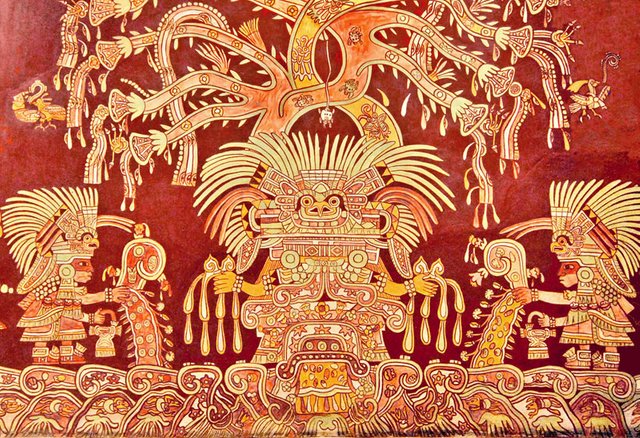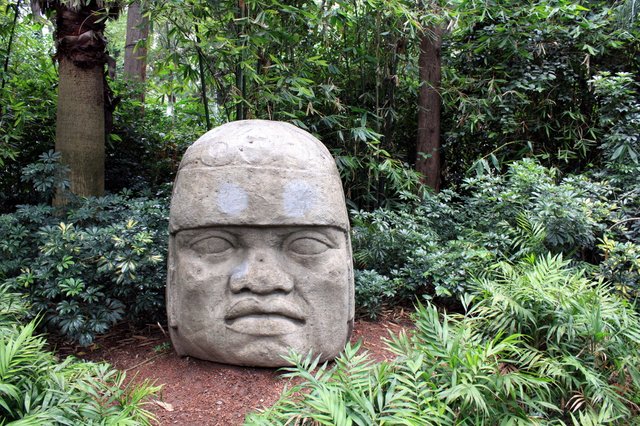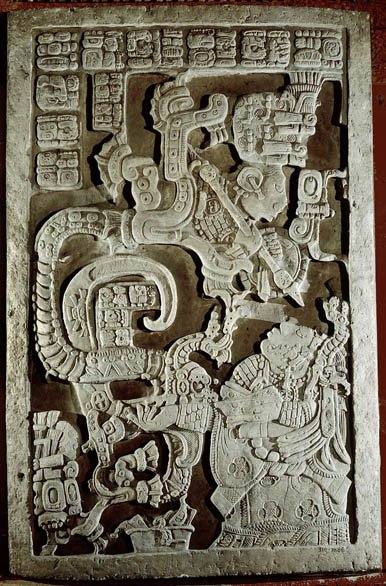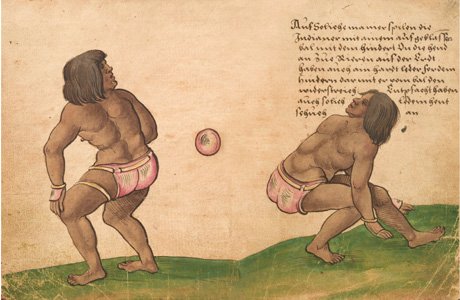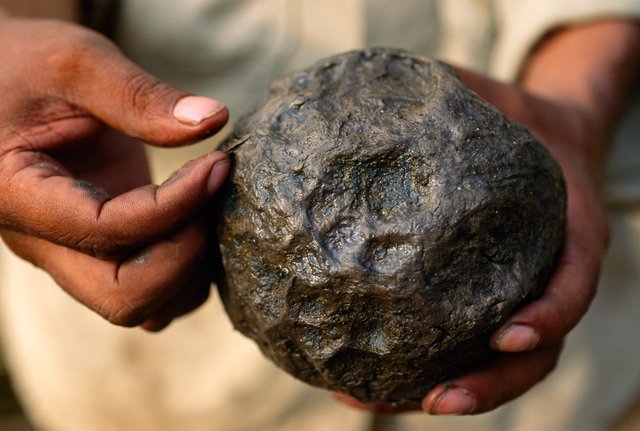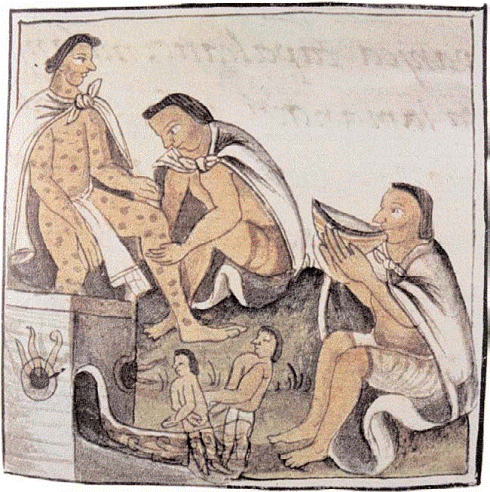Morning Glory plants in Ancient Mesoamerica (Ololiuqui, Rituals, Psychedelics, and Art History)
Morning Glory use in Ancient Mesoamerica
From our current understanding of science, back to the observations of the earliest known civilizations, we have always understood that there exist a profound connection between our life and our surrounding environment. We know that there exist a bond between animals and plants, between celestial bodies in the universe, and these observations of phenomenon have had many different interpretations throughout history. In our Homosapien journey we have found a strong correlation with plants and have expressed our feelings towards them through our art and writings. With our current understanding of biochemistry and botany, many well understood chemical processes may simply be attributed to natural causes, but in early civilizations, foods were surrounded by mythology that rooted the religious beliefs of the time. Many plants were seen as magical for their healing properties or intoxicating effects. The Gods of the ancient civilizations had direct relations to natural phenomenon. Plant life was extremely important in Mesoamerican cultures like the Olmec, Aztec, Maya, Zapotec, and many more. Out of the thousands of plant species located in Mesoamerica, only a few seem to be chosen to be represented with exceptional importance which we can see depicted in art and in writings. The maize plant, cocao tree, Castilla elastic tree, are just a few that fall into this category. Specifically in this essay I will address the importance of of the Morning Glory plant within Mesoamerican cultures and its use throughout their history. The Morning Glory was referred to as the snake plant (coaxihuitl) and had a close relationship to other serpentine figures of mesoamerica such as the vision serpent and the feathered serpent. This psychotropic flora was of great importance to Mesoamerican cultures dating back until the Olmec period.
In order to understand the importance of the morning glory plant in Mesoamerican cultures, we must first fully understand its properties and uses. The morning glory plants you see today in everyday gardens have their indigenous roots in Mesoamerica and tropical areas of South America. To name a few, the Aztec, Maya, and the Zapotec people used this plant in various ways and the use of the morning glory plant goes back to the Preclassic Era in the Olmec civilization. In the Nahuatl language the word describing the seeds of morning-glories, usually referring to the Ipomoea tricolor and Turbina corymbosa, is “ololiuqui”. The word means 'round thing' and refers to the shape of the seed. The seeds were used as a vehicle to other spirit realms and to tap into ethereal knowledge or to even gain healing powers. The use of “ololiuqui” was religiously taken by nobles and the priestly class to reach a clairvoyant state and bring them in dialogue with the spirits they believed lived inside the seeds (164NectarandAmberosa). In the Florentine Codex, Sahagún describes, with slight cultural bias, a drink made from ground “ololiuqui”;
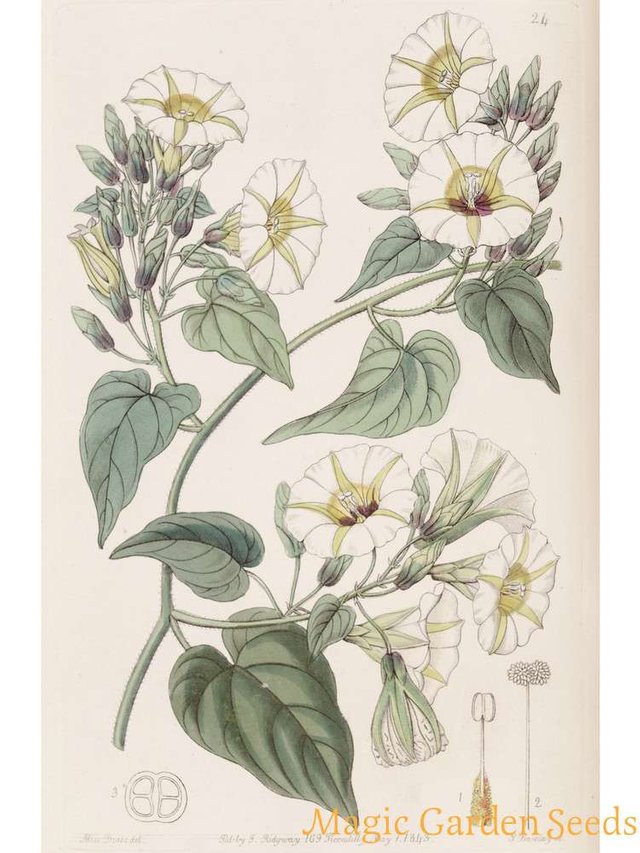
“Its leaves are slender, cord-like, small. Its name is ololiuqui. It makes one besotted;
it deranges one, troubles one, maddens one, makes one possessed. He who eats it, who drinks it, sees many things which greatly terrify him. He is really frightened [by the] poisonous serpent which he sees for that reason. He who hates people causes one to swallow it in drink [and] food to madden him. However, it smells sour; it
burns the throat a little. For gout, it is only spread on the surface.” (Andeacchio)
In an evolutionary perspective, plants and insects have coevolved for thousands of years, so the effects of plants on the human brain are the secondary result of the plants relationship to insects. The similarities between the biochemical processes in human and insects, explains the effects of plant chemicals in our brain. “The central nervous system of humans is biochemically, architecturally, and functionally very similar to that of the insect.” The seeds of these plants contain the psychoactive d-lysergic acid amide, or LSA.
Morning glories were used to treat illnesses. A healer was thought to be able to identify the location of a specific illness and through divine intervention through the use of ololiuqui, or morning glory seeds, was also able to cure the illness (Hofmann, Albert). Ololiuqui was used to treat syphilis, help with flatulence, and even used to remove tumors (Monografía). It was also used as a sedative or pain reliever in fractures and pelvic problems within a women. In powdered form, it could also be applied to painful areas in a case of gout (Monografía). This also relates to the plants use within sacrificial rituals. Morning glory seeds were also taken during autosacrifice and were given to the parents of sacrificial victims to change the state of mind.
In this Mayan stele we see a classic maya vision serpent scene. Lady xoc, the wife of a Maya king who ruled in Yaxchilan from 681, is having a vision (vision serpent), which is a direct reference to entheogen use. Lady xoc looks up in awe towards a vision serpent which represents the mediating force between this world and the underworld. The snake represents the watery underworld and through its mouth you can get a glimpse into this world. In the bottom left near the center of this stele there seems to be 3 morning glory flowers from where the vision serpent emerges from. If you compare the rendering of the morning glory flower in this stele with the morning glory flower found at the frescoes in Malinalco you can clearly see the relationships in iconography. The base of the flower, in both representations, comes out and connects with the rest of the flower in 3 distinct lines. The most interesting and exciting relationship between the two is the representation of the tendril which comes out of the morning glory flower in the fresco painting. The morning glory tendrils are the reason it gets its name “snake plant”, and it is very interesting that it is coming out of the base of the flower, much like the vision serpent is coming out one of the flowers depicted in the stele. This further solidifies the relationships between the morning glory and rituals performed in the Mayan culture.
Hummingbirds play a key role in morning glory pollination and this must be the reason why the humming bird is many times associated with the morning glory. It was believed that the bird would suck the nectar and divine wisdom of the plant. We even see the influence of the hummingbird and morning glory relationship present in the Aztec god Huitzipolitchli.
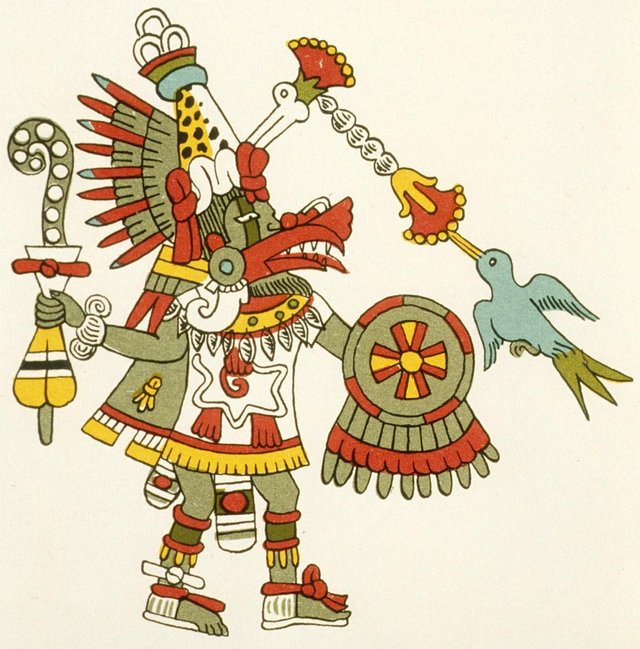
The Aztec deity Huitzilopochtli, whose name means (huitzilin, “hummingbird” and opochtli, “left) Hummingbird on the left (the left handed path) (Halemew). He was the Aztec sun and war god. On his right hand he carries the Feathered Serpent as a blue Snake Plant in his right hand. There is also the iron cross symbol on the shield which is the symbol used for the morning glory (Halemew). The most obvious reference to the plant is how it protrudes out from the forehead where it is met by a humming bird feeding on the nectar, or divine wisdom/knowledge. The snake is in the shape of the morning glory tendril symbol. It is obvious that the God of war Huitzilopochtli was influenced by the humming bird/morning glory relationship, which is a metaphor for the priestly use of the plant. The humming bird can be seen as a user of the morning glory, and the God represents the knowledge and personification of the plant itself.
Although the habitual use of this plant among the general public was most likely looked down upon, along with any other drug substance, it was used within ritual scenarios, and probably culturally restricted to priestly and noble class.
The natural chemical high received from the morning glory plant, allowed the Mayans to create a real life experience and link this experience to the super natural. This solidified world views in the way that experience solidifies reality. In this way, the morning glory plant had a sacred meaning and understanding for the Mayans. This understanding of the psychotropic effects of this plant must have had a strong correlation to the understanding of the ball game. The ball game that itself represents the underworld, a more or less fictional place, and there must have been an agent to stretch the imagination and reality of these people. Psychotropic plants may have been this gateway into the spirit world which allowed the religious narratives to have some sort of validity as shamans and priest ingested them in ritual.
The morning glory plant has hallucinogenic affects that may correlate to the understanding of the world view that the Maya had. We must not dismiss this because our contemporary conservative western bias about drugs and how they affect the mind. The Mesoamerican cultures had a different way of looking at this plant, and just like the maize was looked at like a source of life, so was the morning glory plant seen in a special significance within rituals that translated into normal life and world views of the time, and also in the ball game which dealt with different realities that may have been understood at a deeper level with the use of these plants.
In order to truly understand the deeply rooted significance of the morning glory plant we must look towards the Mesoamerican ballgame. We see the rubber ball game emerge in the Olmec civilization in the pre classical period (2500-100 BCE). The Olmec were cultivating rubber by 1600BC and had the process of creating rubber balls down to a science.
The ball game has to be one of the most iconic defining characteristics of Mesoamerica. Every major Mesoamerican civilizationexperienced the acculturation process and played the ballgame within religious rituals and to even determine ruler ship.
The importance of the ball game shadows the importance of the materials used to make the rubber ball used to play. They were made using a mixture of the sap extracted from the rubber tree (Castilla elastica) and the morning glory root juice (Aguilar). The morning glory root juices inducethe vulcanization process within the rubber making it more flexible and durable. Without the addition of the root juice, the rubber becomes hard and brittle, and would not be accepted by ball player's (Aguilar). This meant that there was an inseparable connection between the morning glory plant and this sacred game.
In the 16th century rubber balls were used as tributes to the Aztec Empire (Aguilar). Thousands of balls were donated yearly. They had created an intricate traderoute system that allowed the disbursement of rubber balls over great distances. This allows us to understand the vastness of the Aztec empire, and their expertise in the production of rubber balls. From Dr. Aguilar’s work, we now know that the mass production of rubber might be much greater than we previously expected. It required extensive amounts of manual labor and required a mass quantity of vulcanized rubber.
We can even see the morning glory plant depicted in the murals in Cloister of the monastery of Malinalco, along with many other important plants native to Mexico.

ololiuqui (morning glory), garden frescoes, Upper cloister Ceiling, Malinalco
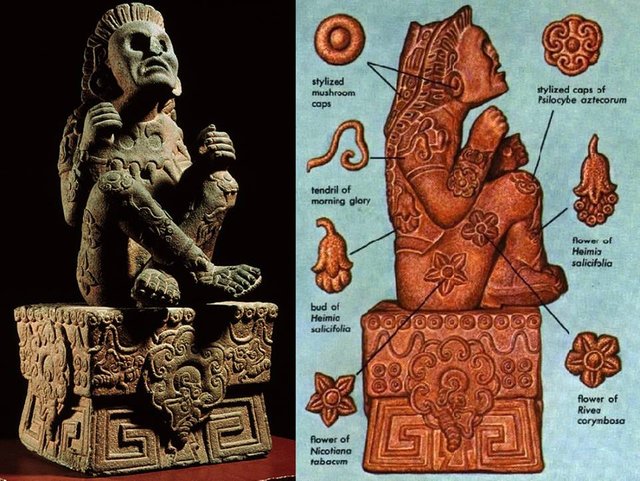
Statue of Xochipilli (From the National Museum of Anthropology, Mexico City)
Here is a statue that was found by the volcano Popocatépetl, near Tlalmanalco. It is from the late post-classical period (1450-1500 CE), and it represent an Aztec god that was related to art, games, beauty, creativity, and most importantly, flowers. His name includes the Nahuatl word for flower, xochitl. The second part of the name, pilli, relates to a noble child, or prince. We can interpret this god’s name as the flower prince. It’s very interesting to note that he was also was the patron of writing and painting. Flowers cover the god statue from head to toe which connect him to the ritual use of entheogens. Psychotropic plants such as the heimia salicifolia, rivea corymbosa, nicotiana tabacum, and hallucinogenic mushrooms are found on his body. These plants are all important entheogens to the Aztec and Mesoamerican culture in general, but I want to focus on the flower of rivea corymbosa, or the morning glory plant. It is depicted on the right thigh of the seated god. Xochipilli seems to be in a glorified trance, which we could assume are the result of any one of these entheogens represented on his body. On his right shoulder, we can see a representation of a morning glory tendril. The morning glory plant was sometimes referred to as coaxihuitl, a Nahuatl word meaning snake plant due to its’ long tendrils. From this sculpture we can get a glimpse into the Aztec psyche and their relationship to these plants. In a way, Xochipilli was a symbol of creativity which was induced by the use of these mind altering plants. This solidifies their use of the morning glory plant as a vehicle into spiritual realms, and shows that it was also influential in creative tasks, such as writing and painting. Many of the iconography used in Mesoamerican art is directly influenced by these entheogens, starting from the noble/priestly class, who used them ritually, and disseminated down to the rest of society.
When the Spanish arrived to Mesoamerica, one of many things that their religious missionaries denied was the use of ololiuqui. The importance of the Morning Glory plant to the Mayans and Aztecs was evident to the Spaniards. Philip II sent Francisco Hernandez on a 5 year expedition in 1570 to gather information about the medicinal plants in Mexico and in 1961 Hernandez published a dense work covering his findings in Mexico entitled “Rerum Medicarum Novae Hispaniae Thesaurus seu Plantarum, Animalium Mineralium Mexicanorum Historian”. Within the work was a chapter all about Ololiuqui (Selin). A translated excerpt from this latin book reads:
“Ololiuqui, which others call coaxihuitl or snake plant, is a climber with thin, green, heart shaped leaves… The flowers are white, fairly large, the seeds are roundish… When the priests of the Indians wanted to visit with the gods and obtain information from them, they ate of this plant in order to become inebriated. Thousands of fantastic images and demons then appeared to them…”(Inlägg)
The Aztecs and Mayans believed they could communicate with the spirits within the morning glory seed and the Spanish missionaries viewed this as a devil worshiping practice, and a tool to talk to demons. Any pagan ritual associated with the seeds had severe punishments. In the chronicles of the Franciscan Friars you can read about how they would burn practitioners at the stake for having ololiuqui in their homes and burned the Morning Glory vines that lusciously covered river banks (Halamew) . The Spaniards ethnocentric bias did not respect the flower’s significance within the Mesoamericans’ religious rituals for hundreds of years. The use of ololiuquiwas hidden in secrecy from the Spanish and ololiuqui is still used today in many parts of Mexico by certain Indian tribes like the Chinatec, Zapotec, Mazatec, and Mixtec (The, Ines). Although, through transculturation, the seeds of the morning glory plant is now referred to as “Semilla de la Virgen”: the seed of the virgin, and “la Manta de la Virgen”: the Virgin’s Cloak . This is a direct reference to the Catholic Virgin Mary. We can see that through transculturation, ololiuqui is still used in a religious context, but with different associations.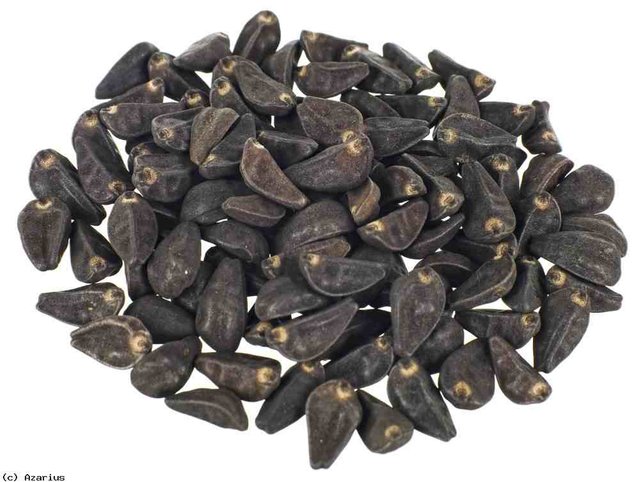
The current use of the morning glory plant proves its importance among the Mesoamerican cultures. We know that every major civilization used Morning glories in the production of rubber, and we know for certain that it was used in many religious practices by the Aztecs and Mayans. Plants will forever be part of our human history and we will continue coevolving with those plants in which we most truly desire most. For the Mesoamerican cultures, the morning glory plant was a tool for a wide variety of things that impacted the overall formation of Mesoamerican beliefs and understandings about the natural world.
